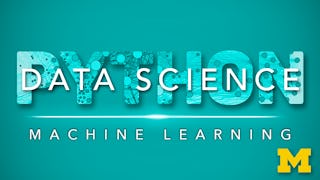By the end of this course, learners will be able to analyze machine learning fundamentals, apply NumPy for numerical computing, visualize data with Matplotlib, and manage structured datasets using Pandas. They will also be able to evaluate supervised and unsupervised models in scikit-learn, optimize performance through validation techniques, and implement advanced applications such as face recognition, text classification, and sentiment analysis.



Machine Learning in Python: Analyze & Apply
This course is part of AI Machine Learning with R & Python Projects Specialization

Instructor: EDUCBA
Access provided by Woxsen University
What you'll learn
Apply NumPy, Pandas, and Matplotlib for data analysis & visualization.
Build, train, and validate supervised & unsupervised ML models.
Implement NLP, face recognition, and text classification projects.
Skills you'll gain
Details to know

Add to your LinkedIn profile
16 assignments
October 2025
See how employees at top companies are mastering in-demand skills

Build your subject-matter expertise
- Learn new concepts from industry experts
- Gain a foundational understanding of a subject or tool
- Develop job-relevant skills with hands-on projects
- Earn a shareable career certificate

There are 4 modules in this course
This module introduces the core concepts of machine learning and the fundamental role of NumPy in Python-based data science. Learners explore the advantages and challenges of machine learning, install and set up NumPy, and perform basic array operations. By the end, students gain a solid foundation for working with numerical data structures in Python.
What's included
14 videos4 assignments1 plugin
This module focuses on data manipulation and visualization using Python’s scientific libraries. Learners advance their NumPy skills with indexing and Boolean operations, visualize data through Matplotlib plots, and master structured data handling with Pandas. These tools form the backbone of efficient exploratory data analysis.
What's included
15 videos4 assignments
This module introduces machine learning models through scikit-learn, covering both supervised and unsupervised approaches. Learners explore datasets, train classifiers, validate models with cross-validation, and evaluate performance metrics. By the end, they understand clustering, dimensionality reduction, and core ML workflows.
What's included
13 videos4 assignments
This module covers advanced applications of machine learning, including face recognition, text classification, and natural language processing. Learners extract features, train classifiers, tune parameters, and conduct sentiment analysis. The skills gained prepare students to apply machine learning in real-world contexts.
What's included
12 videos4 assignments
Earn a career certificate
Add this credential to your LinkedIn profile, resume, or CV. Share it on social media and in your performance review.
Why people choose Coursera for their career




Explore more from Data Science

University of Michigan




